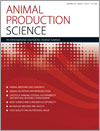
Animal Production Science
Volume 52 Number 4 2012
AN11123 Livestock in no-till cropping systems – a story of trade-offs
Mixed-farming, incorporating cropping and livestock, accounts for nearly half of Australia's farms, but is there a role for livestock with cropping in the long run? This question was examined using a review of scientific literature, information from farmer focus groups and an economic analysis of case study data. Findings reinforced the importance of livestock for farm diversification and to reduce risk, while suggesting that rotational grazing, temporary agistment of livestock or removal to non-cropping areas may improve integration.
AN11195 Estimates of variances due to parent of origin effects for weights of Australian beef cattle
Parental imprinting describes the intriguing genetic phenomenon that the expression of some genes may depend on the sex of the parent from which they were inherited. This paper investigates the importance of such ‘parent of origin’ effects for weights of Australian beef cattle. It is shown that proportion of total variation explained is relatively small and that paternal and maternal imprinting tend to be confounded with sire × herd and maternal genetic effects.
AN11103 Methane yields from Brahman cattle fed tropical grasses and legumes
The methane emissions from the Australian tropical beef herd currently are predicted from one experiment with cattle fed two dried-grass diets. Further research reported here on Brahman cattle fed 19 tropical diets in intensive experiments has resulted in a downward revision of methane production by ~30% compared with the currently used prediction. We present predictive equations using diet characteristics that will assist in the management of the northern beef herd for reduced methane emissions.
AN11087 Effect of mulberry silage supplementation during late fattening stage of Hanwoo (Bos taurus coreanae) steer on antioxidative enzyme activity within the longissimus muscle
This study was conducted to determine the possible application of mulberry silage as a functional feed in the feeding management of Hanwoo, beef cattle. Mulberry silage supplementation resulted in beneficial effects on the antioxidant enzyme activities and scavenging activities against several free radicals, suggesting that it may be a useful natural radical scavenger and potential supplement for the food, pharmaceutical and cosmetic industries as well as cattle feed and/or antibiotics, because of its potent antioxidant capacities. Findings from the present study suggest that mulberry silage may be useful as a functional feed by improving the antioxidant activity against various reactive radicals for beef cattle.
AN11053 Lamb growth performance and carcass weight from rotationally grazed perennial pasture systems compared with annual pasture systems with supplements
Finishing lambs on annual pastures in the temperate zone during summer is challenging and supplementation is required for liveweight gain. Flaxseed and flaxmeal, used as supplements, resulted in lower liveweight gain compared with perennial pasture without supplement, due to lambs selecting the green component of lucerne. Not all areas are suitable for lucerne and research is required to identify other perennial species for lamb finishing.
AN11054 Vitamin E and fatty acid content of lamb meat from perennial pasture or annual pasture systems with supplements
We examined the effect of perennial pastures or annual pastures with supplements on muscle Vitamin E, omega-3 fatty acid concentration and oxidative stability of lamb meat. Muscle vitamin E concentration was higher (5.9 v. 3.4 mg α-tocopherol/kg meat) in lambs grazing perennial pasture compared with lambs grazing annual pasture with supplements, but omega-3 concentration and oxidative stability of fresh meat was not affected. Perennial pasture in lamb feeding systems is beneficial for increasing muscle Vitamin E concentration at slaughter.
AN11181 Effect of replacing barley with corn or sorghum grain on rumen fermentation characteristics and performance of Iranian Baluchi lamb fed high concentrate rations
Feeding barley grains to ruminant livestock competes directly with human food. Productivity of barley in the traditional barley growing arid and semi-arid areas has decreased in recent years due to water shortage resulting from global warming. This article shows that barley could be substituted with drought-resistant sorghum grains with higher animal productivity. This information provides a viable option to continue to produce valuable animal protein for the human population.
AN11127 Effects of pre-incubation upside-down positioning of eggs from breeder flocks with different ages on hatchability and chick quality
Negligence in grading, sorting and packaging eggs into cardboard may cause the eggs to be maintained for 4–5 days in the upside-down position during transportation of the eggs from the farm to the hatchery. Based on the results of this study, upside-down positioning will lead to decreased hatchability and increased chick embryo mortality. This study suggests that the farm and hatchery managers must pay more attention during egg collection, grading and sorting in broiler breeder farms to avoid wrong egg positioning.
AN11138 Nutritional strategies affect carcass and pork quality but have no effect on intramuscular fat content of pork
This experiment investigated the effect of a reduced protein : energy and vitamin A-deficient diet, a high sugar or a high zinc grower phase-supplemented diet, and a lecithin grower-finisher supplemented diet on intramuscular fat levels in pork. The results from this experiment indicate that intramuscular fat content is difficult to manipulate nutritionally from an already moderate amount but that dietary lecithin supplementation has the potential to improve the tenderness of pork. Dietary sugar and zinc increased the amount of lean in the belly and may provide a means to control the ratio of fat to lean in the belly.
AN11239 Incidence of subclinical toxicity in goats and dairy cows consuming leucaena (Leucaena leucocephala) in Thailand
Leucaena is a highly nutritious forage legume, freely available in rural Thailand, but it contains a toxic amino acid, mimosine, that can be degraded by the anaerobic rumen bacteria Synergistes jonesii if present. A survey of the major goat and dairy-producing provinces, where leucaena is the principal dietary component, showed that total DHP concentrations in urine were high, indicative of incomplete degradation by rumen microorganisms. The productivity impact of inoculation of goats and cattle with the rumen organism S. jonesii needs to be further studied.



